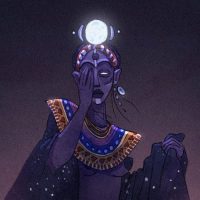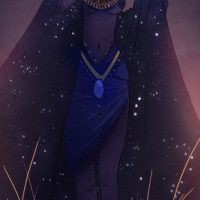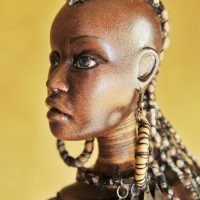Olapa : The Moon Goddess
Listen
At a glance
| Description | |
|---|---|
| Origin | Maasai Mythology |
| Classification | Gods |
| Family Members | Enkai (Husband) |
| Region | Kenya. Tanzania |
| Associated With | Moon, Women |
Olapa
Introduction
In Maasai mythology, Olapa emerges as a pivotal figure, revered as the goddess of the moon. The Maasai, a resilient ethnic group inhabiting East Africa, weave a rich fabric of myths and legends that resonate deeply within their cultural identity. Olapa’s tale intertwines seamlessly with the rhythms of Maasai life, reflecting their spiritual depth and enduring resilience. Revered by her people, Olapa transcends mere mythology, her presence echoing through the oral traditions of the Maasai, where tales of wonder and wisdom abound.
In the vast expanse of East Africa’s plains, beneath the expansive canopy of the night sky, the moon shines as a beacon of serenity and guidance. To the Maasai, this celestial orb embodies the essence of Olapa, the fiery goddess of the moon. Yet, Olapa’s significance extends far beyond her luminous visage; she embodies fertility, menstruation, and the fierce protection of women. She is not just a celestial body but a powerful deity deeply intertwined with the cultural fabric of her people.
Physical Traits
Olapa, often symbolized as the embodiment of the moon, bears a distinctive physical trait: a single eye, a result of a mythical clash with Enkai, the sun god. This characteristic becomes particularly conspicuous during the full moon phase. Artists and storytellers depict Olapa in various forms, each reflecting individual interpretations and cultural nuances. Typically portrayed as a resplendent woman with ebony skin and cascading black hair, she radiates the moon’s ethereal glow. Adorned with ornate jewelry and attire, she embodies the aesthetic richness of Maasai culture.
However, Olapa’s exact appearance remains veiled in mystery, as she seldom materializes physically in Maasai mythology. Her most intriguing aspect lies in her one-eyed countenance, a consequence of her legendary dispute with Enkai. This absent eye is often linked symbolically to the moon’s phases, with the full moon representing her wholeness and the waning crescent symbolizing her injury.
Family
Within the tapestry of Maasai mythology, Olapa is wedded to Enkai, the sun god, in a union marked by a dynamic interplay of power and conflict mirroring the celestial dance of the sun and moon. Yet, Olapa’s familial ties extend beyond her union with Enkai to encompass other celestial deities. Ngai, the supreme creator god, is sometimes depicted as her father or brother, depending on the narrative thread woven. Additionally, Olapa is closely linked to Maasi, the goddess of childbirth, further underscoring her association with female empowerment and the fertility of the earth.
Other names
The designation “Olapa” exhibits the masculine gender prefix “ol,” synonymous with both “moon” and “month” in the Maasai language. While “Olapa” serves as the primary identifier for the moon goddess, she assumes diverse appellations contingent on context and regional nuances within Maasai societies. “Olopoloi” conveys “the one who walks alone,” emphasizing her self-reliant nature and nocturnal dominion. “Olerai” embodies “she who guides,” signifying her pivotal role in navigation and safeguarding.
Powers and Abilities
In her role as the goddess of the moon, Olapa wields formidable power over the nocturnal expanse. Among her many abilities, her most prominent is the capacity to illuminate the darkness, a trait symbolically tied to her singular eye. Olapa’s narrative also hints at her fiery temperament, demonstrated in the legendary altercation where she inflicted a wound upon Enkai. Revered as a patroness of fertility and the menstrual cycle, her influence extends beyond humanity to encompass livestock and the fecundity of the land itself. Acknowledged as the mistress of the tides, she holds sway over fishing and maritime endeavors. However, her dominion transcends terrestrial realms, as she is believed to govern dreams and emotions, bestowing wisdom and clarity during slumber. Moreover, her protective instincts make her an indispensable figure for women, offering guidance through childbirth and shielding them from harm.
Modern Day Influence
The enduring myths and legends of the Maasai, including the captivating tale of Olapa, exert a lasting influence on the cultural traditions of the Maasai people in contemporary times. These narratives are interwoven into the fabric of their daily existence, infusing rituals, ceremonies, and rites of passage with profound spiritual significance. Even amidst the currents of modernity, Olapa’s legacy persists within the Maasai community. Her visage graces traditional adornments and cultural artifacts, symbolizing her enduring significance. As awareness of indigenous belief systems expands, her story resonates with broader audiences, offering invaluable insights into the Maasai worldview and its profound emphasis on celestial harmony and female empowerment.
Related Images
Frequently Asked Questions
What is lorem Ipsum?
I am text block. Click edit button to change this text. Lorem ipsum dolor sit amet, consectetur adipiscing elit. Ut elit tellus, luctus nec ullamcorper mattis, pulvinar dapibus leo.
What is lorem Ipsum?
I am text block. Click edit button to change this text. Lorem ipsum dolor sit amet, consectetur adipiscing elit. Ut elit tellus, luctus nec ullamcorper mattis, pulvinar dapibus leo.
What is lorem Ipsum?
I am text block. Click edit button to change this text. Lorem ipsum dolor sit amet, consectetur adipiscing elit. Ut elit tellus, luctus nec ullamcorper mattis, pulvinar dapibus leo.
What is lorem Ipsum?
I am text block. Click edit button to change this text. Lorem ipsum dolor sit amet, consectetur adipiscing elit. Ut elit tellus, luctus nec ullamcorper mattis, pulvinar dapibus leo.
What is lorem Ipsum?
I am text block. Click edit button to change this text. Lorem ipsum dolor sit amet, consectetur adipiscing elit. Ut elit tellus, luctus nec ullamcorper mattis, pulvinar dapibus leo.






